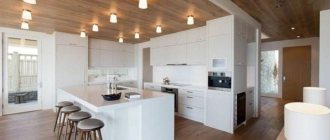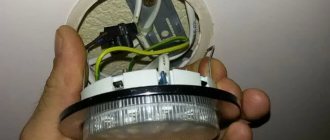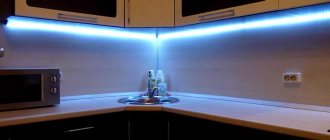In the dark, flashlights help us navigate the streets in the city. And additional illumination and color picture of the streets are created by the illuminated facades of buildings. This lighting should correspond to the style of the building and the general lighting concept in this microdistrict. Therefore, the lighting of city facades must be coordinated with the relevant services. But in this article we will only talk about lighting of country houses and private buildings.
Why do buildings need lighting?
Here everything is both simpler and more complicated. It’s simpler, because you don’t have to coordinate with anyone, but it’s more difficult, because illiterate lighting will not fulfill its functions and, therefore, a lot of money will be thrown away. What functions should façade lighting perform? Several main directions:
- Practical, that is, directly illuminating important areas - stairs, doors, paths.
- Aesthetic – creating interesting design compositions.
- Decorative – highlights elements that you would like to highlight.
In order for everything to work out in the best possible way, think through the lighting devices, their brightness and location in advance and do not neglect the advice of professionals. The purpose of outdoor lighting is:
- improve visibility on the site in the evening and at night;
- draw attention to the house and other important buildings;
- emphasize the beauty of the building and hide its shortcomings and minor flaws;
- create a favorable psychological environment.
Facade lighting makes the house and area cozy, welcoming and safe at any time of the day.
What is architectural home lighting
Architectural lighting for a home is any façade illumination created from an integral system of lighting devices to solve specific problems:
- Emphasize the architecture of the building;
- It is sufficient to illuminate the local area well;
- Make the appearance of the building attractive and seamless.
A properly designed façade lighting system can transform even an extraordinary wooden house, let alone good-quality stone cottages. Moreover, a lighted house is less attractive to thieves (for fear of being noticed), and you won’t have to walk up the steps or find the keyhole in the dark.
External lighting of a country house is a mandatory condition for the safety of its residents
Determining factors and work sequence
When developing a lighting plan, consider:
- External features of housing (color, texture, architectural style).
- Landscape of the site, location of the house on it.
- Where is the point from which the house will look best?
After this, you can start creating the project. Preliminary work consists of several stages:
- First, a general lighting concept is developed and lighting fixtures are selected.
- Electrical networks are prepared taking into account the specified lighting and brightness parameters.
- Equipment (lights, lamps, spotlights) is purchased.
The last stage is the actual installation work and launch of the lighting.
Norms and requirements
When designing and installing street lighting in the yard, it is important to be guided by basic standards, which in the future will ensure not only the ease of use of the local area, but also human safety:
- In accordance with clause 6.3.1 of the PUE for external lighting devices in the yard, you can use lamps of any principle of operation with the exception of security alarm devices, in which the installation of gas-discharge equipment is not allowed
- The installation location of lighting devices can be organized both on free-standing supports and on structural elements of buildings, structures, on the ground, on cables according to clause 6.3.2 of the PUE . But when hanging on a rope in accordance with clause 6.3.4 of the PUE, measures must be taken to prevent them from swinging.
- In relation to the ground, in accordance with clause 6.3.6 of the PUE, you can choose any height, however, when installing yard lighting in the ground, you must provide the installation site with a drainage system.
- If the luminaire is located on any structures below 2.5 m in accordance with clause 6.1.15 of the PUE, their level of protection from dust and moisture must be at least IP54.
- In accordance with clause 6.6.8 of the PUE, the installation of lighting devices must ensure a sufficiently reliable degree of fixation.
- Based on the requirements of clause 6.6.1 of the PUE, the installation location of lighting devices in the yard should be chosen so that there is easy access to it.
- In the regulations of clause 6.6.4 of the PUE , suspended models with a flexible holder are lowered no lower than 1.5 m, otherwise anti-swaying devices are applied to it.
Rules and principles of facade lighting
To ensure that the result does not disappoint, but pleases you, follow the basic principles when installing façade lighting:
- By design, it should be as simple and reliable as possible.
- Economical energy consumption is one of the most important requirements.
- Must comply with all safety standards.
- The possibility of repairing and restoring damaged areas must also be provided for.
- It is highly desirable that the system operate automatically and be controlled from one point.
A “smart” system when organizing facade lighting is absolutely necessary so that you don’t have to run around the house and around the site looking for switches. And finally, the lamps themselves, designed to work outdoors, also have mandatory requirements, without which effective operation is impossible:
- They must have high mechanical strength. It is clear that anything is possible outside: strong wind, rain, snow - the lamp must be able to withstand these natural phenomena. It is also good if it is protected from accidental damage by an impact-resistant diffuser.
- The lamp body is rust-resistant.
- Street lamps must have a high level of dust and moisture resistance. This parameter is indicated by the letters IP and numbers. IP54 is considered optimal for street lamps.
- High heat resistance is also necessary so that on hot summer days, when exposed to direct sunlight, it continues to function.
- All elements of facade lighting must operate uninterruptedly in all weather conditions - rain, fog, snowstorm, that is, have good light output.
Do you need automation?
As you may have noted, in one of the DIY street lighting installation points we mentioned automatic systems. Do they make sense and what is their purpose? Automatic control of street lighting is being used more and more often, because it saves energy. Manual control means turning on the light in the evening and turning it off in the morning as soon as the homeowner wakes up, while the lights perform only one task - scare away ill-wishers.
Now it is better to use motion sensors and automatic photo relays - light sensors. These devices will turn on the light only when moving within their range, as well as in the dark. When motion is detected, the light will turn on immediately, making it easy to monitor safety in the area and at the same time save on electricity.
Types of luminaires for facade lighting
- Ground - the name speaks for itself, they are sunk into the ground and serve mainly to illuminate paths and pools.
- Accent – used for local lighting. Focus attention on what you want to emphasize.
- Spot ones - perform approximately the same task as accent ones, only more concentrated.
- Linear – most often used in contour design.
- Floodlights - flood the house and area with bright light.
And their functions may be different:
- Practical - allows you to safely move around the site, illuminates stairs, doors, and paths around the house.
- Decorative – highlight an interesting detail of the house or an element of landscape design.
- Accompanying - in this case, the lighting fixtures are equipped with special sensors that respond to movement.
Requirements for street lamps
Installation of street light sources involves year-round exposure of lamps and lanterns to a number of meteorological influences.
Taking this factor into account, all purchased lamps must meet a number of requirements:
- Sufficient strength of the products, especially the lampshade.
- Moisture resistant.
- Availability of grounding.
- Ease of practical maintenance of the lamp, especially spring and autumn cleaning.
The photo of the façade lighting shows that all lamps are equipped with durable and moisture-resistant shades.
The shape and design of a garden lamp must fully correspond to the interior of a summer cottage or private house.
Characteristic features of façade lighting
Facade lighting comes in several types:
- Flood - with the help of several spotlights, it illuminates the entire house. Its features are that it floods the building with light from the foundation to the roof, it is universal, it illuminates not only the house, but also the area around it. You can use several types of spotlights - more powerful ones create general diffused light, and smaller ones focus attention on individual details. This is a good solution if you want your home to look the same at night as it does during the day. However, for a small area, and even with dense buildings, this method is not effective and will not allow you to highlight exactly the object you want. If you choose this scenario, think about the proper placement of spotlights. For a low country house (2-3 floors), floodlights located on the ground will direct most of the light into the space, in other words, you will illuminate the night sky, which, of course, is not cost-effective. Therefore, a more correct option is to place spotlights on trees or poles. Another inconvenience is that the light of spotlights aimed at the facade will certainly illuminate the rooms. And it’s okay if it’s a living room, dining room or kitchen. What if the spotlight hits a bedroom or a nursery? This is one of the reasons why this type of lighting is rarely used in country cottages. You can illuminate a service space in this way: a summer kitchen, a cellar, or any other non-residential building.
- Local - used in suburban housing construction much more often. It focuses attention (that’s why it is also called accent) on the most functional and interesting details of the house. In this case, the roof, columns, house number and street name can be highlighted. Facade lamps are used, the light of which can be either diffused or directional. Local lighting can be organized using third-party lighting hidden on the lawn or path. The result is softer lighting. Finally, if you have not a simple country house, but a villa, then you can use both of these methods.
- Silhouette - highlights the entire house, without focusing on details. Its main task is to highlight a building against a dark background, and the light source can be hidden behind the silhouette of the house. Usually it is combined with local illumination.
- Contour - it just focuses attention on architectural details. Lamps are placed in the corners of the house, in window and door openings, along the roof. The entire building can remain in the shadow. Thanks to contour lighting, a building can look even better at night than during the day. It actively participates in festive illumination. To create contour lighting, LED strips, garlands, and multi-colored lamps are used. It is designed to highlight the spectacular features of the exterior.
- Dynamic – allows you to create entire light compositions. It is characterized by a play of colors and shades. This creates a unique artistic image of the building. This is the most effective way to hide his flaws. Modern lighting devices allow you to realize the most incredible fantasies. Thanks to the built-in computer program, the appearance of the building changes depending on weather conditions, the presence or absence of a person in it, the time of day, or simply to the beat of music. Of course, this is a very expensive and time-consuming option, but what an effect! This will be a holiday that is always with you. With the help of dynamic lighting, you can create animation on the facade of the house, you can change color compositions.
Architectural lighting plan
Organizing street lighting for a private home always begins with a project. It doesn’t matter whether you plan to illuminate a cottage or a small country house. This way you will clearly understand the result before installation, and will be able to make timely adjustments, if necessary.
Modern computer programs allow you to visualize any idea; you just need to contact a designer to create a 3D composition. If you don’t want to contact contractors, you can draw up a plan yourself by hand or on the computer.
3D visualization will help you see the result of the lighting project for the facade of a private house even before its installation
To draw up a lighting project for your home, you will need to take into account a number of features:
- The architecture of the building . Too pretentious, bright lighting for a wooden house of classical architecture will look out of place. And the lighting of a modern stone house, consisting of only a couple of spotlights, is boring and uninteresting.
- Distance from neighbors. It happens that you want bright light, but there is a neighboring house a couple of meters away. Then it’s still worth dimming the light so that it doesn’t shine into the neighbors’ windows, causing discomfort.
- Technical installation capabilities. Are you ready to hire a team of professionals or want to do it yourself? Is it possible to install hidden wiring or has the front façade already been finished?
- Lighting solutions in other buildings on the site (if any). Try to follow the general concept if the area is already illuminated. Or consider lighting the gazebo, veranda and other areas of the local area, taking into account the style of facade lighting.
Budget and deadlines.
Decide for yourself how much money and how much time you are willing to spend on creating full-fledged street lighting for your home. The choice of luminaires for façade lighting will directly depend on these parameters.
On a note! It’s good if the architectural lighting plan is drawn up by a specialist. Then he will develop an electrical installation diagram, think over the power supply network, select control methods and a cable layout for the lighting fixtures.
To create a diagram yourself you will also need:
- Mark on the diagram those parts of the structure that are important to highlight.
- Select light sources.
- Schematically depict the location of lamps and auxiliary elements on the plan.
A plan diagram of architectural façade lighting will help you create a competent lighting system, calculate the number of lamps and the cost of purchasing them
Practical nuances: preparing equipment for facade lighting
What equipment is required to fulfill dreams of beauty and round-the-clock functionality of the exterior and site? Of course, first of all it’s lighting technology:
- LED lamps or spotlights. Depending on needs, they can emit static light or change color shades.
- Gas-discharge (fluorescent) lamps.
- LED strips and garlands.
- Duralight is a flexible transparent cord with light bulbs inside.
- Flexible neon is an electroluminescent polyvinyl chloride wire with a copper core.
- Belt-light is a street garland.
Besides:
- Equipment that allows you to control on/off, intensity and direction of light fluxes.
- Equipment that provides protection and fixation of lighting fixtures.
Wonderful opportunities are provided by façade lighting built into the Smart Home system. The system controls the load, checks the state of the electrical network, and can be controlled from a remote control, tablet or smartphone. With a “light movement of your hand,” you can turn on the backlight (or it will turn on automatically at dusk), change the intensity and color palette, and set the automatic shutdown time to save energy.
Functions and purpose
Lighting the yard and surrounding area performs several functions at once:
- Security. In illuminated areas, there is less chance of getting away with impunity, which is why attackers try to avoid such areas. For security, they place lamps near the gate, on the porch, near outbuildings. They are placed at a considerable height to illuminate a larger area. The peculiarity of this type of street lighting is that it stays on all night. There is an option to save money - install motion sensors. With this device, the light turns on only when there is at least some movement in the sensor’s coverage area.
Street lighting of a private house
- Ensuring travel safety. To avoid stepping on something left on the path in the dark, they are also usually illuminated. Lighting is required on stairs and around water bodies. Most often, special street lights with medium-height legs are used for this. They are installed at some distance from each other on one or both sides of the track. This lighting is turned on until the owners go to bed.
It is very important to highlight stairs and paths
- Decorative. To make the yard or garden look no less attractive in the evening than during the day, use decorative lighting. It is usually located on an open veranda, gazebo, near a pond or fountain, or other decorative elements on the site. With such lighting, street wall lamps, garlands, LED strips, etc. are used. This street lighting at home works only when necessary. Decorative lighting gives the garden and yard a special charm
- Festive. To create a festive atmosphere, houses and yards are decorated. Festive illumination is not mandatory, but such a nice type of lighting.
Festive street lighting at home
Usually the lighting on the site of a house - country or country house - is comprehensive. There are at least a lantern at the doors and gates, and a couple of lanterns along the main paths. Floodlights controlled from the house can be installed to illuminate the area if necessary. This is the minimum that ensures a normal degree of safety and convenience.
Light sources for façade lighting
- Gas discharge lamps - they can be mercury, neon, xenon, glow in different colors and generally shine quite brightly. However, the content of harmful substances makes their use and, most importantly, disposal very problematic.
- Fluorescent lamps save energy, shine brightly, last a long time, but also contain harmful substances (in particular, mercury) and are susceptible to low temperatures. Therefore, they are not very good for the street.
- LED lamps are a wonderful invention of the human mind. They consume little electricity, last a long time, can glow in different colors, and are not afraid of “neither heat nor cold.” That is why they are most often used in street lighting.
Creating a lighting scenario for architectural lighting is a task that requires creative thinking, knowledge of the features of lighting technology, because outdoors it is subject to additional stress, the ability to accurately calculate all project parameters, a good sense of style and a professional approach.
A little about the efficiency of outdoor lighting
The priority of using LED equipment in outdoor lighting is not accidental: such lighting devices are extremely economical in terms of energy consumption. For small households, in which the role of an external lighting system is played by one or two lanterns near the gate and front door, this is not very relevant. But for medium and large areas, when the street lighting system uses several dozen lamps, electricity consumption by the “street” alone can reach several kilowatts per day.
In addition, when using LED emitters, it is quite simple to arrange outdoor lighting for an area that does not have a power supply line at all. Manufacturers produce a large number of LED lamps, completely autonomous and powered by solar panels (panels). It is quite difficult to organize full-scale illumination of an area with them for many hours - however, with a small size of the illuminated area, the use of such lamps allows you to save a good amount.
Types: wall-mounted, hanging for local areas
There are:
- Hanging
- Wall mounted
- LED
- With motion sensors
- With light sensors
- Lamps built into the ground or sidewalk.
The sizes of curb stones are described in detail in this article.
All types of lamps for the garden or home are airtight and resistant to environmental influences. You can buy any of them in specialized lighting stores.
When selecting lighting fixtures for a summer house or home, you should pay more attention to lamps, since they are the ones that affect the lighting effects:
- Hanging . Suspended at a distance from the ceiling. They are held using a chain with height adjustment up to 1 m. The best places to use hanging models: the exterior of the building, as well as canopies, gazebos and other outdoor structures.
- Wall mounted . These models are installed on building facades, supports, low columns and consoles. They can also be built into steps or a wall thanks to a plastic case with a special fastening, and they can also be used to automatically illuminate the stairs.
- LED . LED models effectively save energy (2-3 times compared to other types of lighting) and are distinguished by an aesthetically pleasing appearance. As well as increased service life and high reliability. Such models work well at low temperatures and have shockproof properties.
The best lighting devices for your site
Initially, we choose street lights for our dacha, based, of course, on external characteristics. And only then do we think about the functionality of the lighting device.
Decide on the following points:
- general climatic conditions that the lantern must endure;
- humidity;
- temperature amplitude, daily and seasonal;
- wind activity and wind rose for your territory.
If the conditions are harsh, you can compensate for this with high-quality materials for the lamp. Paying a little extra for the flashlight at the beginning will ultimately benefit you in terms of service life.
When choosing a lamp for your site, study the energy consumption standards. In the price-quality ratio of a lamp, service life is also important. Very often, taking into account the durability and energy consumption of a light lamp, you can save a lot.
Solar street lights justify their cost with a very long service life, despite the price of one bulb. Accumulating light during the day, they release it at night. This is a choice not only for those who want to save money, but also for those who care about the environment.
For spot accents, LED street lights are best. Landscape designers actively use these lamps to create the effect of soft and unobtrusive lighting.











